看到一篇很不错的博文,分析一下代码,记录基于esp32cam视频流媒体的处理方法。
项目资源:
包含Arduino esp32支持库,所以文件压缩包很大
链接:https://pan.baidu.com/s/1nmW9xb8g2TuIy_dV_ibeEA
提取码:khhe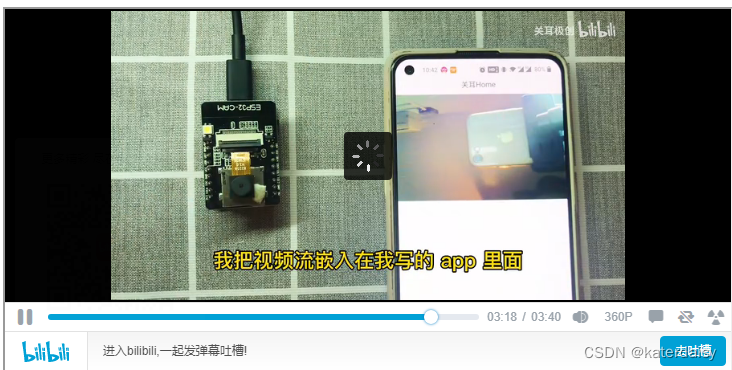
启动Webserver,处理客户端网页的三种http请求:
在主任务Server Connection Handler Task: mjpegCB()函数中注册esp32 webserver要处理的三个网页服务。
server.on(“/mjpeg/1”, HTTP_GET, handleJPGSstream);
server.on(“/jpg”, HTTP_GET, handleJPG);
server.onNotFound(handleNotFound);
处理客户端网页只抓取一张图片的请求
对应于server.on(“/jpg”, HTTP_GET, handleJPG)服务: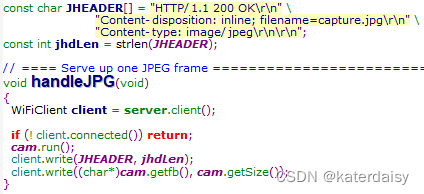
cam.run(); //打开照相机
client.write(JHEADER, jhdLen);//通知客户端,只发送一张图片
client.write((char*)cam.getfb(), cam.getSize());//把这张图片发送给客户端
处理客户端网页请求视频(连续画面)的请求
对应的server.on(“/mjpeg/1”, HTTP_GET, handleJPGSstream)服务: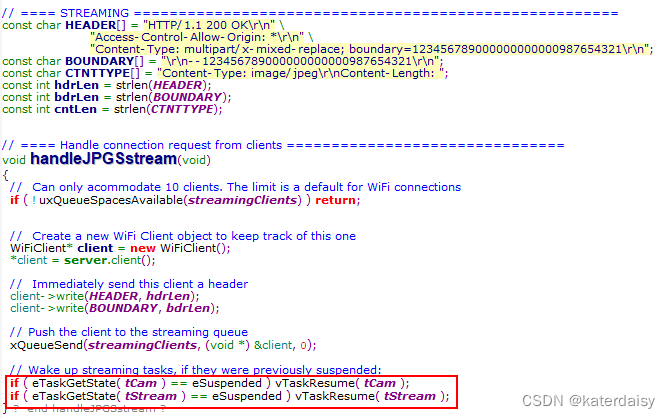
上图中红框处唤醒了相机拍照进程和图像传输进程。
这两个进程也是在主任务Server Connection Handler Task: mjpegCB中被创建: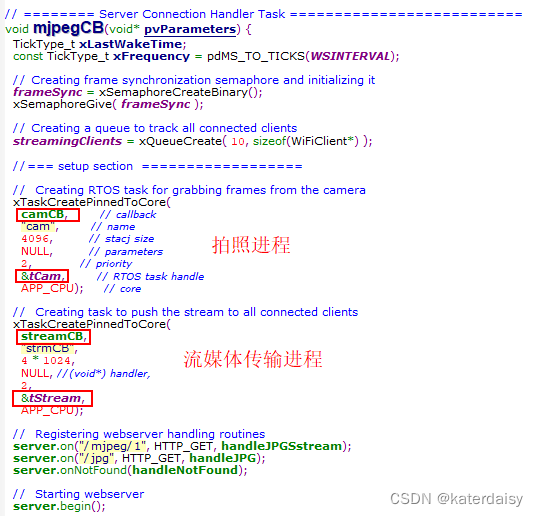
camCB任务负责拍照。拍照完成后,通知传输进程传输图片给客户端。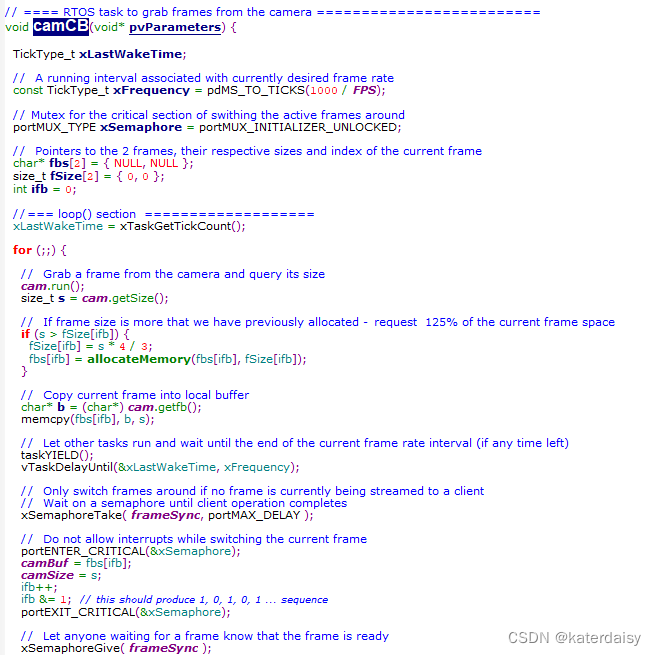
传输进程streamCB收到拍照通知后,并判断是否仍然有客户端连接。如果仍然有客户端链接,就把图片传输给客户端。反复判断,反复传输图片,就形成了视频流。
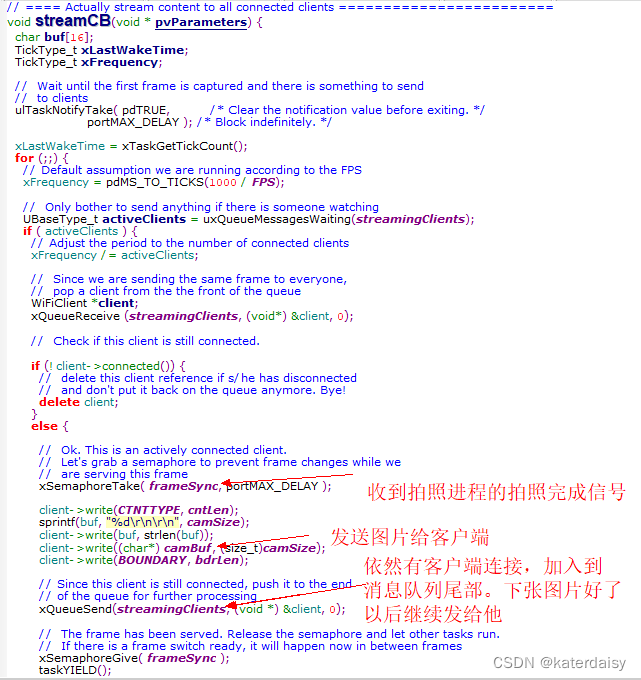
server.onNotFound(handleNotFound)服务:
直接发送一窜信息给客户端:
主程序代码
/*
This is a simple MJPEG streaming webserver implemented for AI-Thinker ESP32-CAM
and ESP-EYE modules.
This is tested to work with VLC and Blynk video widget and can support up to 10
simultaneously connected streaming clients.
Simultaneous streaming is implemented with FreeRTOS tasks.
Inspired by and based on this Instructable: $9 RTSP Video Streamer Using the ESP32-CAM Board
(https://www.instructables.com/id/9-RTSP-Video-Streamer-Using-the-ESP32-CAM-Board/)
Board: AI-Thinker ESP32-CAM or ESP-EYE
Compile as:
ESP32 Dev Module
CPU Freq: 240
Flash Freq: 80
Flash mode: QIO
Flash Size: 4Mb
Patrition: Minimal SPIFFS
PSRAM: Enabled
*/
// ESP32 has two cores: APPlication core and PROcess core (the one that runs ESP32 SDK stack)
#define APP_CPU 1
#define PRO_CPU 0
#include “OV2640.h”
#include <WiFi.h>
#include <WebServer.h>
#include <WiFiClient.h>
#include <esp_bt.h>
#include <esp_wifi.h>
#include <esp_sleep.h>
#include <driver/rtc_io.h>
// Select camera model
//#define CAMERA_MODEL_WROVER_KIT
//#define CAMERA_MODEL_ESP_EYE
//#define CAMERA_MODEL_M5STACK_PSRAM
//#define CAMERA_MODEL_M5STACK_WIDE
#define CAMERA_MODEL_AI_THINKER
#include “camera_pins.h”
/*
Next one is an include with wifi credentials.
This is what you need to do:
- Create a file called “home_wifi_multi.h” in the same folder OR under a separate subfolder of the “libraries” folder of Arduino IDE. (You are creating a “fake” library really - I called it “MySettings”).
- Place the following text in the file: #define SSID1 “replace with your wifi ssid” #define PWD1 “replace your wifi password”
- Save.
Should work then
*/
#include “home_wifi_multi.h”
OV2640 cam;
WebServer server(80);
// ===== rtos task handles =========================
// Streaming is implemented with 3 tasks:
TaskHandle_t tMjpeg; // handles client connections to the webserver
TaskHandle_t tCam; // handles getting picture frames from the camera and storing them locally
TaskHandle_t tStream; // actually streaming frames to all connected clients
// frameSync semaphore is used to prevent streaming buffer as it is replaced with the next frame
SemaphoreHandle_t frameSync = NULL;
// Queue stores currently connected clients to whom we are streaming
QueueHandle_t streamingClients;
// We will try to achieve 25 FPS frame rate
const int FPS = 7;
// We will handle web client requests every 50 ms (20 Hz)
const int WSINTERVAL = 100;
// ======== Server Connection Handler Task ==========================
void mjpegCB(void* pvParameters) {
TickType_t xLastWakeTime;
const TickType_t xFrequency = pdMS_TO_TICKS(WSINTERVAL);
// Creating frame synchronization semaphore and initializing it
frameSync = xSemaphoreCreateBinary();
xSemaphoreGive( frameSync );
// Creating a queue to track all connected clients
streamingClients = xQueueCreate( 10, sizeof(WiFiClient*) );
//=== setup section ==================
// Creating RTOS task for grabbing frames from the camera
xTaskCreatePinnedToCore(
camCB, // callback
“cam”, // name
4096, // stacj size
NULL, // parameters
2, // priority
&tCam, // RTOS task handle
APP_CPU); // core
// Creating task to push the stream to all connected clients
xTaskCreatePinnedToCore(
streamCB,
“strmCB”,
4 * 1024,
NULL, //(void*) handler,
2,
&tStream,
APP_CPU);
// Registering webserver handling routines
server.on(“/mjpeg/1”, HTTP_GET, handleJPGSstream);
server.on(“/jpg”, HTTP_GET, handleJPG);
server.onNotFound(handleNotFound);
// Starting webserver
server.begin();
//=== loop() section ===================
xLastWakeTime = xTaskGetTickCount();
for (;😉 {
server.handleClient();
// After every server client handling request, we let other tasks run and then pause
taskYIELD();
vTaskDelayUntil(&xLastWakeTime, xFrequency);
}
}
// Commonly used variables:
volatile size_t camSize; // size of the current frame, byte
volatile char* camBuf; // pointer to the current frame
// ==== RTOS task to grab frames from the camera =========================
void camCB(void* pvParameters) {
TickType_t xLastWakeTime;
// A running interval associated with currently desired frame rate
const TickType_t xFrequency = pdMS_TO_TICKS(1000 / FPS);
// Mutex for the critical section of swithing the active frames around
portMUX_TYPE xSemaphore = portMUX_INITIALIZER_UNLOCKED;
// Pointers to the 2 frames, their respective sizes and index of the current frame
char* fbs[2] = { NULL, NULL };
size_t fSize[2] = { 0, 0 };
int ifb = 0;
//=== loop() section ===================
xLastWakeTime = xTaskGetTickCount();
for (;😉 {
// Grab a frame from the camera and query its size
cam.run();
size_t s = cam.getSize();
// If frame size is more that we have previously allocated - request 125% of the current frame space
if (s > fSize[ifb]) {
fSize[ifb] = s * 4 / 3;
fbs[ifb] = allocateMemory(fbs[ifb], fSize[ifb]);
}
// Copy current frame into local buffer
char* b = (char*) cam.getfb();
memcpy(fbs[ifb], b, s);
// Let other tasks run and wait until the end of the current frame rate interval (if any time left)
taskYIELD();
vTaskDelayUntil(&xLastWakeTime, xFrequency);
// Only switch frames around if no frame is currently being streamed to a client
// Wait on a semaphore until client operation completes
xSemaphoreTake( frameSync, portMAX_DELAY );
// Do not allow interrupts while switching the current frame
portENTER_CRITICAL(&xSemaphore);
camBuf = fbs[ifb];
camSize = s;
ifb++;
ifb &= 1; // this should produce 1, 0, 1, 0, 1 ... sequence
portEXIT_CRITICAL(&xSemaphore);
// Let anyone waiting for a frame know that the frame is ready
xSemaphoreGive( frameSync );
// Technically only needed once: let the streaming task know that we have at least one frame
// and it could start sending frames to the clients, if any
xTaskNotifyGive( tStream );
// Immediately let other (streaming) tasks run
taskYIELD();
// If streaming task has suspended itself (no active clients to stream to)
// there is no need to grab frames from the camera. We can save some juice
// by suspedning the tasks
if ( eTaskGetState( tStream ) == eSuspended ) {
vTaskSuspend(NULL); // passing NULL means "suspend yourself"
}
}
}
// ==== Memory allocator that takes advantage of PSRAM if present =======================
char* allocateMemory(char* aPtr, size_t aSize) {
// Since current buffer is too smal, free it
if (aPtr != NULL) free(aPtr);
size_t freeHeap = ESP.getFreeHeap();
char* ptr = NULL;
// If memory requested is more than 2/3 of the currently free heap, try PSRAM immediately
if ( aSize > freeHeap * 2 / 3 ) {
if ( psramFound() && ESP.getFreePsram() > aSize ) {
ptr = (char*) ps_malloc(aSize);
}
}
else {
// Enough free heap - let’s try allocating fast RAM as a buffer
ptr = (char*) malloc(aSize);
// If allocation on the heap failed, let's give PSRAM one more chance:
if ( ptr == NULL && psramFound() && ESP.getFreePsram() > aSize) {
ptr = (char*) ps_malloc(aSize);
}
}
// Finally, if the memory pointer is NULL, we were not able to allocate any memory, and that is a terminal condition.
if (ptr == NULL) {
ESP.restart();
}
return ptr;
}
// ==== STREAMING ======================================================
const char HEADER[] = “HTTP/1.1 200 OK\r\n”
“Access-Control-Allow-Origin: *\r\n”
“Content-Type: multipart/x-mixed-replace; boundary=123456789000000000000987654321\r\n”;
const char BOUNDARY[] = “\r\n–123456789000000000000987654321\r\n”;
const char CTNTTYPE[] = "Content-Type: image/jpeg\r\nContent-Length: ";
const int hdrLen = strlen(HEADER);
const int bdrLen = strlen(BOUNDARY);
const int cntLen = strlen(CTNTTYPE);
// ==== Handle connection request from clients ===============================
void handleJPGSstream(void)
{
// Can only acommodate 10 clients. The limit is a default for WiFi connections
if ( !uxQueueSpacesAvailable(streamingClients) ) return;
// Create a new WiFi Client object to keep track of this one
WiFiClient* client = new WiFiClient();
*client = server.client();
// Immediately send this client a header
client->write(HEADER, hdrLen);
client->write(BOUNDARY, bdrLen);
// Push the client to the streaming queue
xQueueSend(streamingClients, (void *) &client, 0);
// Wake up streaming tasks, if they were previously suspended:
if ( eTaskGetState( tCam ) == eSuspended ) vTaskResume( tCam );
if ( eTaskGetState( tStream ) == eSuspended ) vTaskResume( tStream );
}
// ==== Actually stream content to all connected clients ========================
void streamCB(void * pvParameters) {
char buf[16];
TickType_t xLastWakeTime;
TickType_t xFrequency;
// Wait until the first frame is captured and there is something to send
// to clients
ulTaskNotifyTake( pdTRUE, /* Clear the notification value before exiting. /
portMAX_DELAY ); / Block indefinitely. */
xLastWakeTime = xTaskGetTickCount();
for (;😉 {
// Default assumption we are running according to the FPS
xFrequency = pdMS_TO_TICKS(1000 / FPS);
// Only bother to send anything if there is someone watching
UBaseType_t activeClients = uxQueueMessagesWaiting(streamingClients);
if ( activeClients ) {
// Adjust the period to the number of connected clients
xFrequency /= activeClients;
// Since we are sending the same frame to everyone,
// pop a client from the the front of the queue
WiFiClient *client;
xQueueReceive (streamingClients, (void*) &client, 0);
// Check if this client is still connected.
if (!client->connected()) {
// delete this client reference if s/he has disconnected
// and don't put it back on the queue anymore. Bye!
delete client;
}
else {
// Ok. This is an actively connected client.
// Let's grab a semaphore to prevent frame changes while we
// are serving this frame
xSemaphoreTake( frameSync, portMAX_DELAY );
client->write(CTNTTYPE, cntLen);
sprintf(buf, "%d\r\n\r\n", camSize);
client->write(buf, strlen(buf));
client->write((char*) camBuf, (size_t)camSize);
client->write(BOUNDARY, bdrLen);
// Since this client is still connected, push it to the end
// of the queue for further processing
xQueueSend(streamingClients, (void *) &client, 0);
// The frame has been served. Release the semaphore and let other tasks run.
// If there is a frame switch ready, it will happen now in between frames
xSemaphoreGive( frameSync );
taskYIELD();
}
}
else {
// Since there are no connected clients, there is no reason to waste battery running
vTaskSuspend(NULL);
}
// Let other tasks run after serving every client
taskYIELD();
vTaskDelayUntil(&xLastWakeTime, xFrequency);
}
}
const char JHEADER[] = “HTTP/1.1 200 OK\r\n”
“Content-disposition: inline; filename=capture.jpg\r\n”
“Content-type: image/jpeg\r\n\r\n”;
const int jhdLen = strlen(JHEADER);
// ==== Serve up one JPEG frame =============================================
void handleJPG(void)
{
WiFiClient client = server.client();
if (!client.connected()) return;
cam.run();
client.write(JHEADER, jhdLen);
client.write((char*)cam.getfb(), cam.getSize());
}
// ==== Handle invalid URL requests ============================================
void handleNotFound()
{
String message = “Server is running!\n\n”;
message += "URI: ";
message += server.uri();
message += "\nMethod: ";
message += (server.method() == HTTP_GET) ? “GET” : “POST”;
message += "\nArguments: ";
message += server.args();
message += “\n”;
server.send(200, “text / plain”, message);
}
// ==== SETUP method ==================================================================
void setup()
{
// Setup Serial connection:
Serial.begin(115200);
delay(1000); // wait for a second to let Serial connect
// Configure the camera
camera_config_t config;
config.ledc_channel = LEDC_CHANNEL_0;
config.ledc_timer = LEDC_TIMER_0;
config.pin_d0 = Y2_GPIO_NUM;
config.pin_d1 = Y3_GPIO_NUM;
config.pin_d2 = Y4_GPIO_NUM;
config.pin_d3 = Y5_GPIO_NUM;
config.pin_d4 = Y6_GPIO_NUM;
config.pin_d5 = Y7_GPIO_NUM;
config.pin_d6 = Y8_GPIO_NUM;
config.pin_d7 = Y9_GPIO_NUM;
config.pin_xclk = XCLK_GPIO_NUM;
config.pin_pclk = PCLK_GPIO_NUM;
config.pin_vsync = VSYNC_GPIO_NUM;
config.pin_href = HREF_GPIO_NUM;
config.pin_sscb_sda = SIOD_GPIO_NUM;
config.pin_sscb_scl = SIOC_GPIO_NUM;
config.pin_pwdn = PWDN_GPIO_NUM;
config.pin_reset = RESET_GPIO_NUM;
config.xclk_freq_hz = 20000000;
config.pixel_format = PIXFORMAT_JPEG;
// Frame parameters: pick one
// config.frame_size = FRAMESIZE_UXGA;
// config.frame_size = FRAMESIZE_SVGA;
// config.frame_size = FRAMESIZE_QVGA;
config.frame_size = FRAMESIZE_VGA;
config.jpeg_quality = 12;
config.fb_count = 2;
#if defined(CAMERA_MODEL_ESP_EYE)
pinMode(13, INPUT_PULLUP);
pinMode(14, INPUT_PULLUP);
#endif
if (cam.init(config) != ESP_OK) {
Serial.println(“Error initializing the camera”);
delay(10000);
ESP.restart();
}
// Configure and connect to WiFi
IPAddress ip;
WiFi.mode(WIFI_STA);
WiFi.begin(“wifi账号”, “wifi密码”);//WIFI名称和密码
Serial.print(“Connecting to WiFi”);
while (WiFi.status() != WL_CONNECTED)
{
delay(500);
Serial.print(F(“.”));
}
ip = WiFi.localIP();
Serial.println(F(“WiFi connected”));
Serial.println(“”);
Serial.print(“Stream Link: http://”);
Serial.print(ip);
Serial.println(“/mjpeg/1”);
// Start mainstreaming RTOS task
xTaskCreatePinnedToCore(
mjpegCB,
“mjpeg”,
4 * 1024,
NULL,
2,
&tMjpeg,
APP_CPU);
}
void loop() {
vTaskDelay(1000);
}
————————————————
版权声明:本文为CSDN博主「perseverance52」的原创文章,遵循CC 4.0 BY-SA版权协议,转载请附上原文出处链接及本声明。
原文链接:https://blog.csdn.net/weixin_42880082/article/details/123448688
———————————————
版权声明:本文为CSDN博主「perseverance52」的原创文章,遵循CC 4.0 BY-SA版权协议,转载请附上原文出处链接及本声明。
原文链接:https://blog.csdn.net/weixin_42880082/article/details/123448688
版权归原作者 katerdaisy 所有, 如有侵权,请联系我们删除。